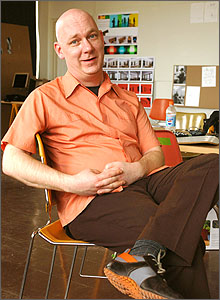Archives
Shepard straddles two fields
New faculty member helped to develop dual-degree program
By JESSICA KELTZ
Reporter Contributor
Mark Shepard, assistant professor of architecture and media study, came to UB for the unique opportunity to help get a dual-degree program off the ground, and explore and combine his interests in two very different, yet very complementary fields of study.

Mark Shepard came to UB to help
start a dual-degree master’s program in architecture and media
study.
PHOTO: NANCY J. PARISI
"That's part of what attracted me," Shepard says of the new dual-degree program, which allows students to combine master's degrees in architecture and fine arts—building expertise in both architecture and digital media. "No other architecture school is doing this in the U.S. right now, so there was a real opportunity to develop a curriculum and a program that would be unique."
Shepard began his career at Cornell University, where he earned an undergraduate degree in architecture in 1991. He worked in Switzerland for a year, then in San Francisco for another before earning master's degrees in architectural design (from Columbia University) and fine arts (from CUNY Hunter College) as the Jacob K. Javits Fellow in the Humanities.
"After graduating, I was doing a combination of things," Shepard recalls.
He exhibited his work in festivals and was a founding member of a new media company called dotsperinch (www.dotsperinch.com). Described as "an experimental practice for architecture, film and digital media technologies," dotsperinch was part of the team that won the first Peabody Award for new media with the Sonic Memorial Project (http://www.sonicmemorial.org ), a cross-media collaboration that documents the history of the World Trade Center. Dotsperinch produced the project in collaboration with National Public Radio's Lost and Found Sound.
"I had been in New York for 10 years when this position was advertised," Shepard says of his UB appointment. "It was a perfect opportunity for me."
At UB, Shepard holds faculty positions in both the Department of Media Study and the School of Architecture and Planning.
He says the new dual-degree program provides both architects and media artists with a conceptual framework for the development of the advanced skills necessary to address an emergent confluence of architecture and digital media.
"Digital media and information systems are rapidly permeating the built environment. Moving beyond immersive, screen-based interactive environments, digital media today incorporates hybrid spaces that integrate both the virtual and actual dimensions of everyday life," he explains.
Shepard's architecture design-studio students are developing prototypes for observational devices—whether that means something you physically look through, or just something that helps you understand your environment in a new way—that mediate between the observer and the world, with a focus on airports.
One student's project layers images culled from two Webcams—one placed on a floor directly above the other—to give viewers a sense of activity going on in two places that look exactly alike.
Another looks at the "static" places in airports—in this case, places where people wait in John F. Kennedy International Airport—and allows viewers to learn more about one another as a group. Shepard explains that a traveler scans his or her boarding pass into a machine that records his or her place of origin and final destination. It then assigns a colored puzzle piece to each traveler, so that when the pieces fit together, it creates a sort of picture of the people waiting.
In terms of his own projects, Shepard plans to exhibit his Tactical Sound Garden Toolkit, an open-source software platform for cultivating virtual community sound gardens in public spaces, this summer at the Inter-Society for Electronic Arts (ISEA)/ZeroOne San Jose Global Festival of Art on the Edge Symposium and Festival.
"It was quite an honor to be selected for it," Shepard says of the ISEA festival.
The project also will be presented as part of a panel discussion at the Subtle Technologies Festival in Toronto in June, he adds.
After almost two semesters at UB, Shepard says he's been impressed with the quality of UB students and with his departments, where both chairs have been very flexible in dealing with his dual appointment.
"Generally, it works out that 75 percent of your time is in one department and 75 percent of your time is in the other," he laughs. Right now, time is especially tight because he's been trying to attend full rounds of faculty meetings in both units, he says.
"It's all about time management," he notes. "I enjoy the diversity within the space of a day between two places. And I'm getting to know the Millersport Highway very well."
Buffalo also has proved to be a hospitable place to live and work, Shepard says, adding that while he still lives part-time in New York City, he spends more time here.
"I find that Buffalo has enormous potential in terms of what's here," he says, pointing out that vacant and under-used spaces that work for installations and other cutting-edge art are much more available here than in larger cities. "There's a certain freedom here that supports a level of experimentation that's not found in major cities today."
Shepard says he finds Buffalo to be "a very livable place."
"It has a vibrant cultural life if you know where to look" he says. "The availability of housing is great. And the people, too. I keep having to remind myself that Buffalo is in the Midwest—people are more open and friendly here."
He adds: "It was a very mild winter...I was prepared for worse."
